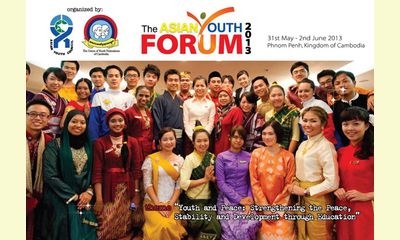|
|
Asian youth gather in Cambodia to discuss peace, development
un article par Xinhua Chinese News Service
The 2013 Asian Youth Forum opened here on Friday to
exchange views on strengthening peace, stability and
development through education, announced Hun Many,
President of Union of Youth Federation of Cambodia.

Photo from Facebook
click on photo to enlarge
The two-day forum brought together youth delegates
from 22 countries of the Asian Youth Council,
including Malaysia, Cambodia, China, Brunei, South
Korea and Mongolia, he said.
"They would discuss challenges, share experiences
and reflect their commitments to a significant and
proactive role in building a culture of peace and
development in the region in particular and the
world at large," said Hun Many, son of Prime
Minister Hun Sen.
Addressing the opening ceremony, Prime Minister
Hun Sen said the forum provided a rare opportunity
for Cambodian youth to share views on
strengthening peace, stability and development in
the region and the world, as well as share
experiences and create regional network.
"I am really proud of Asian youth who are
dynamically working together for the cause of peace,
development and prosperity in each country, the
region and the world," the premier said.
"This is the real spirit of cooperation and
partnership that must take root among youth, the
core force of development in the future."
He said the forum, held under the theme "Youth and
Peace: Strengthening Peace, Stability and
Development through Education", was right and
timely in the context that the possibility of
turmoil and civil war were threatening many
countries and regions.
The recent experiences of Arab Spring and the
ongoing civil wars in some countries would remind
every youth to always remember their obligation and
significance in protecting and maintaining the tree
of peace, he added.
"Careless acceptance of irresponsible rhetoric and
political propaganda from outside may bring about
great danger to the whole society for the long
term," the premier advised.
The forum was also attended by Dato' Seri Dr.
Mohamad Khir Toyo, President of the Asian Youth
Council. At the end of the forum, the Asian Youth
Council will adopt a Joint Declaration and present
it to the Minister of Cambodian Ministry of
Education, Youth and Sports. Endi
|








|
DISCUSSION
Question(s) liée(s) à cet article:
Does a culture of peace require that there be no violence?,
* * * * *
Commentaire le plus récent:
The initial target article for this question, concerning the Asian Youth Forum in Cambodia, quotes the Cambodian Prime Minister warning the youth not to follow the example of the Arab Spring because it has led (at least in some cases) to violent civil wars.
But does this mean that the Arab Spring has not promoted a culture of peace? Not at all according to articles in CPNN.
How should this paradox be understood?
Let us go back to that great master of nonviolence, Mahatma Gandhi. According to him, the key is that we must always address injustice, whether or not there is a question of violence involved. In fact, to quote Martin Luther King, "Nonviolent resistence is not a method for cowards. It does resist. If one uses this method because he is afraid or merely because he lacks the instruments of violence, he is not truly nonviolent. This is why Gandhi often said that if cowardice is the ony alternative to violence, it is better to fight . . . while the nonviolent resister is passive in the sense that he is not physically aggressive toward his opponent, his mind and emotions are always active, constantly seeking to persuade his opponent that he is wrong. The method is passive physically, but strongly active spirtually. It is not passive non-resistance to evil, it is active nonviolent resistance to evil.
So, we may conclude that Asian youths should emulate the Arab Spring in the spirit of non-violence, and should not turn away from it because there was sometimes violence involved. The quest of justice is a constant quest!

|
|









